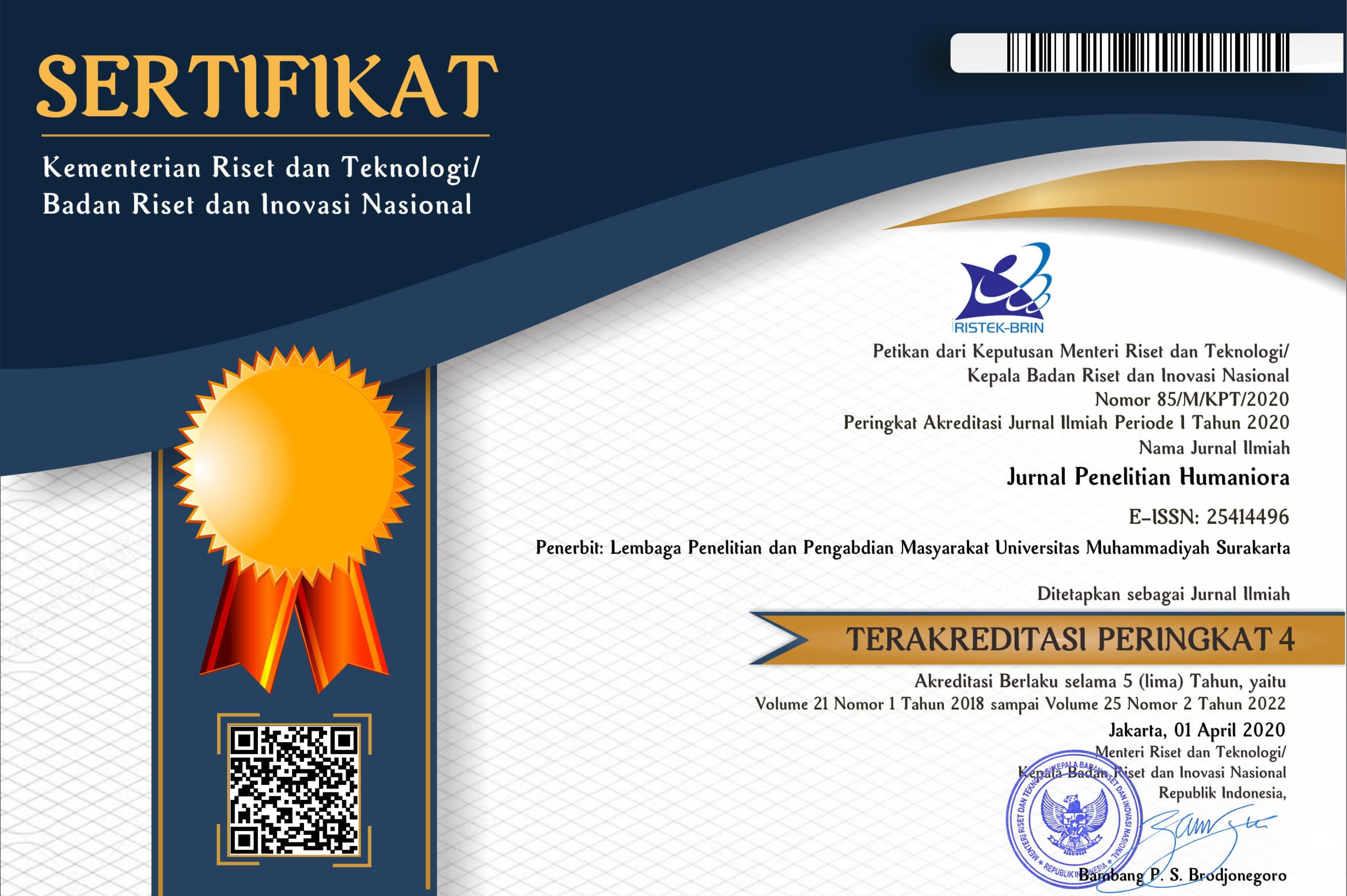PIRANTI KOHESI GRAMATIKAL DAN LEKSIKAL PADA WACANA RUBRIK "SELEBRITAS" DALAM MAJALAH FEMINA SEBAGAI BAHAN AJAR MENULIS TEKS NARASI
Nila Prima Septianingrum(1*), Atiqa Sabardila(2)(1) Universitas Muhammadiyah Surakarta
(2) Universitas Muhammadiyah Surakarta
(*) Corresponding Author
Abstract
Keywords
Full Text:
PDFReferences
Chaer, Abdul. 2012. Linguistik Umum. Jakarta: PT Rineka Cipta.
Chao, Chunhong. 2014. “Lexical Cohesion of Sino-British College Student’s EAP Writing”. Scholarly Journals. Volume 4 Number 10. Pages 2123-2128.
Ghufron, Syamsul. 2012. “Peranti Kohesi dalam Wacana Tulis Siswa: Perkembangan dan Kesalahannya”. Jurnal Bahasa dan Seni. Volume 6 Nomor 2. Halaman 1-12.
Lestari, Ika. 2013. Pengembangan Bahan Ajar Berbasis Kompetensi. Padang: Akademia Permata.
Mulyana. 2005. Kajian Wacana: Teori, Metode & Aplikasi Prinsip-Prinsip Analisis Wacana. Yogyakarta: Tiara Wacana.
Nabifar, Nesa and Gholamreza Rostami. 2015. “A Constrative Study of Lexical Cohesion Used in Sport Texts in Washington and Tehran Times Newspapers Written by English Native and Iranian Authors”. Modern Journal of Language Teaching Methods. Volume 5 Number 4. Pages 549-558.
Olajoke, Akinkurolere Susan. 2015. “A Lexical Analysis of an Inaugural Speech of the Speaker of Benue State House of Assembly in Nigeria”. Journal of Language Teaching and Research. Volume 6 Nomor 2. Pages 258-264.
Parwati, Edin. 2011. “Kohesi Leksikal Repetisi pada Wacana “Wayang Durangpo” dalam Surat Kabar Harian Jawa Pos Edisi Februari-April 2010”. Jurnal Artikulasi. Volume 12 Nomor 2. Halaman 807-816.
Prasetia, I Made Prapta. 2013. “Penggunaan Piranti Kohesi dalam Karangan Narasi Oleh Siswa Kelas VII SMP Negeri 1 Blahbatuh”. Jurnal Jurusan Pendidikan Bahasa dan Sastra Indonesia. Volume 1 Nomor 8. Halaman 1-14.
Rani, Abdul, Bustanul Arifin, dan Martutik. 2006. Analisis Wacana: Sebuah Kajian Bahasa dalam Pemakaian. Malang: Bayumedia Publising.
Rassouli, Masoumeh dan Mehdi Abbasvandi. 2013. “The Effects of Explicit Instruction of Grammatical Cohesive Devices on Intermediate Iranian Learner’s Writing”. European Online Journal of Natural and Social Sciences. Volume 2 Number 2. Pages 15-22.
Rohmadi, Muhammad dan Yakub Nasucha. 2015. Dasar-Dasar Penelitian Bahasa, Sastra, dan Pengajaran. Surakarta: Pustaka Briliant.
Sudaryanto. 1993. Metode dan Aneka Teknik Analisis Bahasa. Yogyakarta: Duta Wacana University Press.
Tim Redaksi KBBI Pusat Bahasa. 2014. Kamus Besar Bahasa Indonesia. Jakarta: PT Gramedia Pustaka Umum. Edisi IV Cetakan Kedelapan.
Zarepour, Fatemeh. 2016. “Cohesion Analysis of Iranian Advanced EFL Learner’s Writing”. Journal of Language Teaching and Research. Volume 7 Number 2. Pages 408-414.
Article Metrics
Abstract view(s): 1782 time(s)PDF: 4394 time(s)
Refbacks
- There are currently no refbacks.











